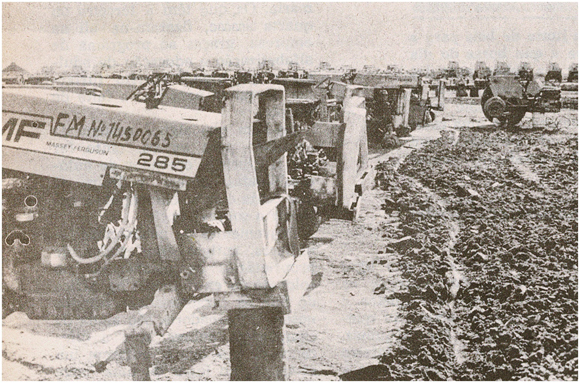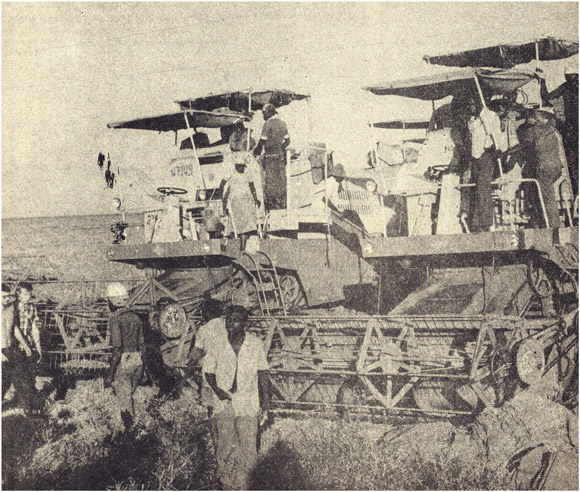State Farms
(including CAIL and CAIA),
1974-1992
Dossiers MZ-0095 and MZ-0159
![]()
Between 1976 and 1991, over 100 agricultural enterprises, the state farms, totalling perhaps one million ha. in area were run by the Frelimo Party government. This was not the result of a nationalisation programme, but rather the outcome of interventions made necessary by the collapse of commercial farming after the flight of skilled Portuguese settlers at independence. Together with agricultural cooperatives and communal villages (aldeias comunais), the larger, mechanised state farms constituted key elements in Mozambique’s post-independence project of building socialist agriculture and initially received the most attention and the majority of available resources. The state farms represented the technologically modern component in the transformation of agriculture but were ultimately unsuccessful for a combination of reasons. These included not only the impact of the war with RENAMO but also managerial, technical, and financial difficulties and the pursuit of mistaken policies such as an over-reliance on mechanisation.

Above: Working tractors being driven to the fields at CAIL in 1982. Mechanisation was controversial, and the state farms struggled to find skilled drivers and machanics to keep equipment in working order.
As early as 1981, it was clear that state farms were running at a loss, and after the Fourth Congress of Frelimo in April 1983 some of the larger ones were broken up into smaller units in a search for efficiency. The Complexo Agro-Industrial do Limpopo, or CAIL, was the biggest of these farms, but other important enterprises included CAIA (the Complexo Agro-Industrial de Angónia) in Tete province and UPBL (the Unidade de Produção do Baixo Limpopo).
By 1989, it had been decided that those farms that produced export-oriented cash crops would be maintained, and the others would be divested or switched to joint ventures. However, there was some resistance to this, as some senior government figures believed that the ongoing conflict was the main reason for the continuing unprofitability of the sector. Nevertheless, in July 1990 the then prime minister, Mário Machungo, publicly argued for the privatisation of the remaining state farms, which had accumulated a sectoral debt of around US$79 million. The course of privatisation was, however, far from straightforward, and community land claims, as well as the rights of members of cooperatives, often fell by the wayside in what amounted to a scramble for resources, especially as the state farms were often located on the best land with good access to water sources.

Above: Workers moving heavy agricultural machinery by main force at CAIL in 1982. The newspapers and magazines of the period frequently featured articles praising the activities of the state farms, and most especially CAIL. Examples are included in the dossier.
CAIL was located in Chókwè, in Gaza province, and was the largest of all the state farms in the period between 1977 and 1983. It was markedly unsuccessful. It was established by the government in 1977 on 5,000 ha. of land from the abandoned and defunct Colonato do Limpopo but rapidly increased in size to 16,000 hectares of mainly irrigated rice fields stretching for 70 kilometres along the southern bank of the Limpopo River. CAIL produced vegetables and some tobacco and was highly mechanised, with a large stock of tractors and combine harvesters, many from Bulgaria, the Soviet Union, and the German Democratic Republic. The complex included a factory for milk products, plants for processing rice and tomatoes, and a sausage factory.
Rice yields were poor and fell dramatically from 1979, with the 1981 figure only 2.7 tons per ha., about half of the planned target. The figures for the 1982 harvest were never released. Maintenance of the sophisticated machinery remained a major problem, as did the complex’s reliance on seasonal casual labour, which was often unavailable because peasants were harvesting their own food crops. In 1983 the Fourth Congress of the Frelimo Party recognised that the large state farms had been swallowing resources at the expense of the cooperative and family sectors and were seriously inefficient. CAIL was then broken up into several smaller state farms, most of which were eventually privatised.

Above: A tractor graveyard at CAIL in the early 1980s. The model in the foreground is a Massey-Ferguson 285 model, made in Canada and widely considered to be a reliable workhorse.
CAIA was located in Angónia district in Tete province, an area with fertile soil, reliable rainfall, and a moderate climate, and in the decades before independence the Portuguese had begun to produce maize, potatoes, vegetables, and fruit there, using fertiliser and some degree of mechanisation. The Casa Agrícola, a large agricultural enterprise, farmed several thousand ha. in this way, but with the coming of independence the technicians fled and the company was left in a state of chaos. Casa Agrícola was taken over by a state company, the Unidade de Produção de Angónia (UPA), which expanded to absorb other abandoned lands and in 1979 was renamed CAIA. The new farm was organised into nine blocks, each administered on a day-to-day basis by a field office reporting to the main headquarters. The total area of the farm (as reported in 1991) was over 22,000 ha.

Above: Combine harvesters photographed at CAIL in 1982. The mechanisation policy on the state farms was unsuccessful, at least partly but by no means exclusively because the farms lacked the capacity to maintain complex machinery in working order, or the funds to obtain spare parts from overseas (even from Mozambique’s socialist “natural allies”.
In 1980 CAIA had supplied a significant proportion of the agricultural production of the whole province of Tete, but by August 1987 the Angónia plateau was facing famine, and the state farm was no longer functioning. Between 1984 and 1987, RENAMO attacked the enterprise nine times, destroying tractors and farm machinery and driving most of the workforce away. Refugees who escaped to neighbouring Malawi only began to return in mid-1992.
![]()
Click on the yellow folder image below to download a zipped file of the dossier of 59 press reports and documents in PDF format. New items will be added from time to time. This version of the dossier is dated 6 March 2021.
![]()



![Aluka: Struggles for Freedom [subscription required] Struggles for Freedom](imgs/aluka_200.png)



